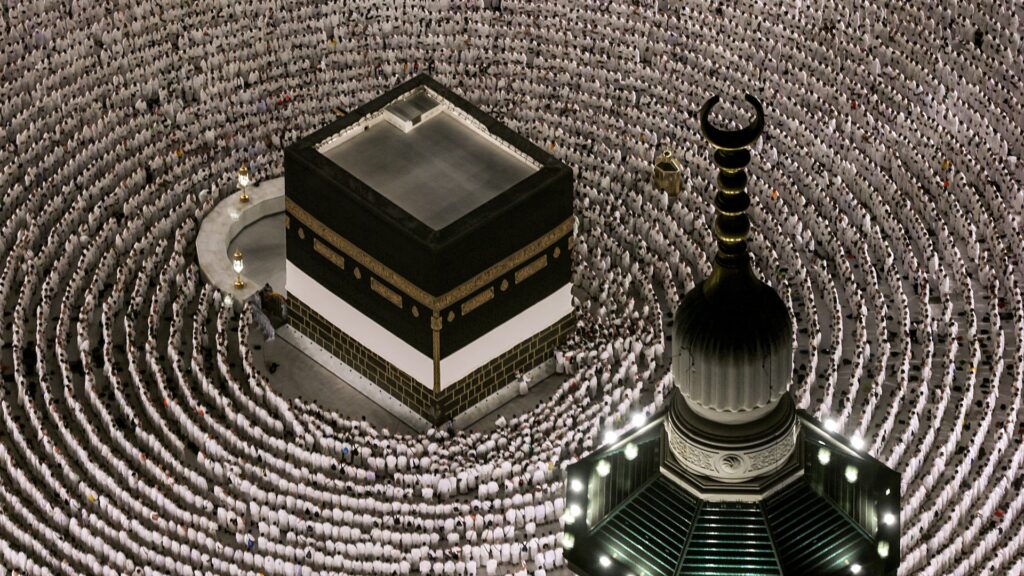Every year, millions of Muslims from across the world gather in Saudi Arabia to perform Hajj – an annual Muslim pilgrimage.
One of the largest gatherings in the world, more than two million Muslims are expected to take part from around 188 countries. This year, Hajj season falls between 4 and 9 June.
The pilgrimage takes place over a period of several days and culminates in Eid al-Adha, a day of celebration enjoyed by Muslims around the globe whether or not they took part in the Hajj itself.
Eid al-Adha will begin on Friday 6 June and last for three days until Sunday 9 June.
Hajj is a religious obligation on all Muslims who are healthy, financially able, of sound mind and of age to perform the pilgrimage.
New MEE newsletter: Jerusalem Dispatch
Sign up to get the latest insights and analysis on
Israel-Palestine, alongside Turkey Unpacked and other MEE newsletters
One of the philosophies of the Hajj is that of spirituality and unity. All Muslims perform the same rites and are encouraged to share in a spirit of equality.
All pilgrims are to remain in a state of purity and simplicity during the Hajj as much as possible. This includes wearing simple clothes, which for men includes two pieces of white unsewn cloth. Women are not restricted to a specific colour but are also encouraged to wear non-elaborate clothing.
Mina
The very first rite of the Hajj is to make intention, niyah in Arabic, when entering ihram – a pilgrim’s sacred state – before arriving at Mecca’s boundaries known as the Miqat.
Before entering the sacred city, men must wear plain garments – two unstitched pieces of white cloth, whilst women must wear loose-fitting clothes.
After entering Mecca in Ihram, many pilgrims perform an initial Tawaf by circling the Kaaba seven times in a counterclockwise direction.
Pilgrims can then perform the sa’i, a ritual of walking seven times between the hills of Safa and Marwa, located within the Grand Mosque.
The pilgrims then set out en masse to the sprawling tent-city of Mina.
Here, Saudi authorities have set up over 100,000 tents and temporary shelter for the pilgrims in what looks like a huge tent city.
The pilgrims spend most of their time in Mina in prayer and solemn reflection before setting out the next morning at dawn.
Arafat
On the second day of the Hajj, pilgrims arrive at a hill known as Mount Arafat, also known as the Mount of Mercy.
This is considered to be a great day of forgiveness and the day is spent repenting for past sins.
Muslims believe that if you spend this day in a state of true repentance, all past sins will be forgiven.
Muslims around the world who cannot physically take part in the Hajj also spend this day engaged in prayer, fasting and supplication.
Muzdalifa
After sunset, pilgrims head to Muzdalifa – some 9km away – where they spend the night under the stars.
Pilgrims spend their time in prayer and also gather 49 pebbles to be used in rituals over the next three days.
Jamarat
Pilgrims leave Muzdalifa before dawn and begin heading back to Mina.
Once in Mina, on the third day of Hajj, they perform the first rami, throwing seven pebbles at the largest of three columns known as Jamarat.
The Jamarat is a ritual and symbolic stoning of the devil. Three pillars – small, medium and large – are stoned by pilgrims with the pebbles they collected on their route from Muzdalifa the night before.
The story associated with the stoning of the devil relates to the devil’s attempt to dissuade Prophet Ibrahim (Abraham) from obeying Allah’s commands.
In past years, so many people gathered to take part in this ritual that people were crushed and trampled. That has led to the Saudi authorities attempting to modernise the walkways and access points to the area to make it safer for pilgrims.
Eid
After casting their stones, pilgrims return to Mina for the first day of Eid al-Adha, or the Feast of the Sacrifice. This is the second of the two annual Islamic holidays.
Muslims throughout the world celebrate Eid on this day.
In remembrance of the willingness of Prophet Ibrahim (Abraham) to make any sacrifice commanded of him by God, pilgrims must sacrifice an animal – or more likely, pay for it to be done in their names – and distribute a portion of that meat to the poor.
At this point, male pilgrims trim or shave their hair while women are only required to cut a lock of their hair. Pilgrims are then allowed to remove their ihram and wear other forms of comfortable clothing.
Many will then proceed to Mecca to perform tawaf and sa’ee, first circling the Kaaba seven times, then walking seven times between the hills of Safa and Marwa.
When all is finally done, they return to their campsite in Mina.
For the next two days, on day four and five, pilgrims will again symbolically stone the devil – this time throwing seven pebbles at each of the three pillars – a total of 21 on each day.
Farewell tawaf
When their time in Mina is finished, the pilgrims return to Mecca to perform the final or farwell tawaf – circling of the Kaaba.
The Kaaba is an ancient stone structure in Mecca towards which all Muslims around the world face to pray five times a day.
Muslims believe that the Kaaba was the first place of worship built on Earth and that it was originally built by the Prophet Adam, the first man created by God.
Pilgrims walk around, or circumambulate, it seven times in a counter-clockwise direction.
Although not a part of the Hajj itself, many people round off their pilgrimage with a visit to Medina and the site of the grave of the Prophet Muhammad since, for most, this will be a once-in-a-lifetime journey.







